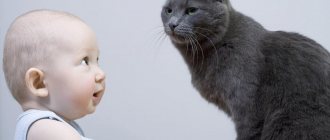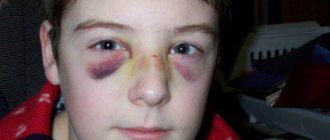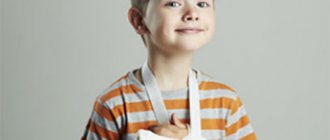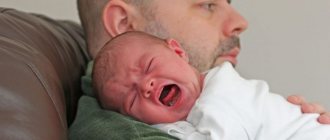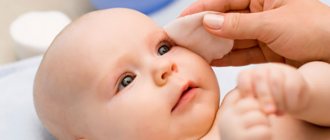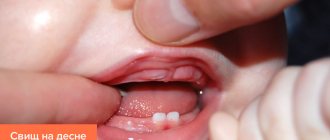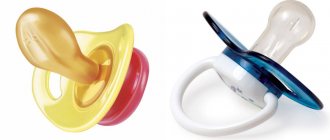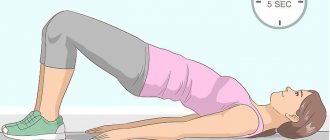The Diagnostic and Statistical Manual of Mental Disorders, 5th edition (DSM-5) defines autism spectrum disorder. It combines several diseases: Asperger's syndrome, childhood disintegrative disorder, PDD - pervasive developmental disorders. But in first place on the list of autism spectrum disorders is autism, in the context of which early childhood autism (ECA) is distinguished.
Classic autism
Autism is a disease whose core symptoms are impaired social interaction. That is, such a child has an absent or very poorly developed level of communication with others, and sometimes with close people.
Difficulties in communication manifest themselves both verbally and non-verbally. The child’s speech may be practically undeveloped or its accelerated development may be noted. He may have a huge vocabulary, but cannot engage in dialogue.
Nonverbal disorders are associated with difficulties in establishing visual contact, originality of postures, facial expressions, and gestures. An indicative criterion is the lack of empathy, that is, the ability to empathize with other people, understand their feelings, show care, compassion, be sad or rejoice with them.
The classic triad of RDA symptoms are:
- low level of social interaction, mutual communication;
- meager sphere of interests;
- stereotypical movements.
The disease manifests itself up to 3 years of age. Its first signs can be detected in the first year of life, but most parents attach importance to them when the child is 2 years old and older.
Signs of autism remain with a person throughout life to varying degrees. To date, scientists have not yet found a way to completely cure it.
Autism is associated with a disorder of the brain.
Research confirms that the development of the nervous system is influenced by the immune system even in the early stages of embryonic development, or, more precisely, by its insufficient function.
There is a theory that autistic individuals have an underdeveloped mirror neuron system. These cells are excited during motor activity, as well as when observing the activity of other people. For this reason, such people do not have the opportunity to adopt the behavior of others and monitor them.
Despite the large amount of research into the causes of the disease, the question of its nature remains open. Numerous theories reflecting on this problem do not provide a clear and complete answer.
Genetic factors
Researchers at the Sinai School of Medicine believe that one of the causes of ASD is mutations in three genes:
- CHD8 – regulates the transfer of genetic information from DNA to RNA,
- SNC2A – encodes one of the brain proteins
- KATNAL2 – the functions of this gene are not fully understood.
The researchers say that with further study of these genes, they will be able to develop new therapeutic and preventative strategies for autism.
“We found 10 percent of the genes that influence autism,” said Joseph Buchsbaum, Ph.D., director of the Seaver Center for Autism and professor of psychiatry, genetics and neuroscience at Sinai School of Medicine.
“We need to study many more parents and their affected children if we are to uncover the genes important for finding the cause of ASD. This will lead to early diagnosis and new drug development. This work is critical to advancing autism treatments.”
Autism is often similar to Martin-Bell syndrome, so it would be a good idea to take genetic tests for the fragile X chromosome. This is a rare genetic disease, a so-called chromosomal abnormality, which leads to insufficient expression of the FMR1 protein, which ensures normal development of the nervous system.
The development of Rett syndrome is associated with a mutation in the MECP2 gene, which is located on the X chromosome.
Story
The concept of “autism” was first described in 1911 by Eugen Bleuler, but it was considered in the context of schizophrenia, as one of its symptoms. Translated from Latin, it means “abnormal narcissism.” With this term, the psychiatrist tried to indicate the patient’s withdrawal into his inner world, isolation from the intrusive interference of outsiders, and separation from reality. In its modern interpretation, it began to be used at the suggestion of Hans Asperger, after whom one of the autism spectrum disorders, Asperger syndrome, was named.
The concept of “early childhood autism syndrome” was introduced into psychiatry by Leo Kanner. In 1943, he introduced the term “autism” into a completely new context by describing the stories of 11 children and diagnosing them with infantile autism. He pointed out that this condition is markedly different from schizophrenia in children. In the picture of the disease, he noted the presence of symptoms such as stereotypical movements and echolalia. One of the variants of ASD, Kanner syndrome, was also named in honor of Leo Kanner.
Clinical picture
The main symptoms of RDA appear in infancy, in children in the first year of life. The following signs are noteworthy:
- late onset of babbling;
- smile little;
- do not fix their gaze on other people;
- lack of reaction in response to an adult’s appeal;
- do not respond to their own name;
- react sharply to weak stimuli, for example, minor noise, with strong negative emotions: crying, screaming, fear. But they react weakly to strong stimuli;
- After feeding, the baby does not express pleasure. There is no impression of a contented, satisfied baby.
Children with signs of autism have a perverted animation complex. This is the name of the emotional-motor response of a baby to the activity of an adult towards him. This simple form of behavior is formed by the end of the first month. It persists and intensifies until 4 months of age, and then disappears.
The structure of the revitalization complex includes the following components:
- prolonged fixation of gaze on an adult;
- smile addressed to the parent;
- verbal expression of emotions - cooing, humming, exclamations;
- motor reactions in the form of swinging arms and legs, head movements, and bending of the body.
In children with ASD, the reactions of the complex, as already mentioned, are perverted, very weakly expressed or completely absent. Such a child does not ask to be held, does not calm down when his mother takes him in her arms.
Another option is also possible, when the reactions of the revitalization complex are fully manifested, but not to an adult, but to any object, for example, a favorite toy or a pattern on wallpaper, a light bulb.
An autistic infant reacts poorly to parents and other loved ones, looks as if through them, does not express positive emotions in their presence, and does not come into contact with them. There is a disturbance in the baby's activity. Such children are called comfortable - they are too calm and undemanding.
As for motor development, it does not initially cause concern. All significant motor skills develop on time: independently holding the head, turning from back to stomach and back, sitting down. Children also begin to get up and walk on time, but there may be a time gap between walking with support and stomping independently—often it lasts up to six months.
In the further development of motor skills, the following tendency is observed: they are sluggish, unrhythmic, uncoordinated, characterized by stiffness, tightness and tension. Children often walk on their toes.
However, there are children with ASD, on the contrary, who are particularly nimble and flexible. They are very mobile. They tumble and easily climb heights. They keep their balance well. They say about these people: they can get through everywhere.
Signs of autism in children
Depending on the age and severity of the disease, children may have different signs of autism. But doctors usually talk about four main symptoms of autism in children, which do not appear individually, but all together:
- the child does not seek to communicate with anyone, does not interact with parents, peers, or animals; or this interaction is minimized or distorted;
- if a child enters into communication with someone, he does it with the help of gestures, without resorting to words and without trying to build a dialogue;
- the child behaves according to a strictly defined pattern;
- All these symptoms in the behavior of children with autism appear at an early age.
Therefore, it is worth paying attention to the very early signs (from 3 months to 2 years) of autism in children:
- the child does not show interest in his parents: he does not walk, does not smile, does not move his arms and legs, trying to show joy in their presence;
- does not try to find mother or father with his eyes, does not maintain eye contact;
- does not show a desire to contact a loved one: does not reach out, does not look for the breast (may even refuse breastfeeding);
- does not want to play with someone - adults or children, reacts aggressively to the offer to play together;
- increased sensitivity to light, sounds, physical contact, which manifests itself as fear, screaming, hysteria;
- the child demands to repeat only certain actions: swing on the swing all the time, wear only these trousers, walk only along the edge of the sidewalk, etc.;
- up to 2 years of age, normal speech development occurs, and then speech skills regress and turn into mindless repetition of phrases after adults;
- disturbed sleep, poor appetite, desire to eat the same foods or dishes;
- does not respond to requests to show or bring something, or to his own name;
- the child is unable to express a request for help;
- when trying to play, the child usually acts alone and simply arranges objects according to some characteristics (height, color, etc.), does not create role-playing games, does not invent stories;
- strong attachment to regimes and routines: categorically does not want to change the daily routine or route, does not allow objects to be swapped, etc.
Later (from 2 to 11 years) symptoms of autism in children:
- the pronoun “I” is absent in the child’s speech; speech is based on repeating “adult” phrases heard on the street, on TV, from adults, using phrases out of context, lack of desire to build a dialogue with someone;
- children with autism syndrome practically do not perceive danger: they are not afraid of heights, moving vehicles, animals; however, they may become frightened and aggressively perceive household objects - a fork, a brush, a kettle, etc.;
- repetition of the same gestures and movements: rocking from side to side, spinning, etc.;
- unreasonable attacks of laughter, fear, aggression;
- in children with autism syndrome, cognitive development may be impaired in some places, and in some places manifest itself as increased observation: for example, a child who cannot learn to read is able to notice details that are inconspicuous to others, reproduce complex melodies, and perform operations with numbers;
But even when these signs appear very clearly, a parent cannot be completely sure of the diagnosis of autism in their child. The final diagnosis can only be made by a psychiatrist after studying the entire clinical picture of what is happening. After all, some children with autism may not conform to the behavior described above at all. For example, some autistic children are able to maintain physical contact and even communicate. But at the same time, they cannot recognize non-verbal signals and emotions of people, or determine signs of aggression emanating from a person or animal.
Further development
By the end of the first year of life, it can be noticed that autistic children suffer from such a developmental component as joint activity between an adult and a child, which includes common experiences of pleasure and interest in joint activities and play.
Such kids have difficulty getting involved in joint activities. They find it difficult to connect emotionally with adults. It is significant when a child is pointed at an object with his hand, but he only looks at the hand; the object itself is uninteresting to him. For his part, he rarely points to an object on his own in order to share emotions. The pointing gesture is not formed or the child may point to something with an adult’s hand.
Because of this, children poorly develop such components of mutual coordination as following the parent’s gaze, imitating his behavior, and responding to his own name. The child does not respond to even the most banal request.
1 year is a crisis period in the life of all children. It is especially difficult for an autistic child. The possibility of independent movement leads to regression of even the slightest communications that took place.
In the baby's poses there is no request to pick him up, while healthy children at this age clearly demonstrate this with a familiar gesture: for example, they stop and extend their arms to the parent.
By the age of 3, children with ASD already have a clear formation of this syndrome. At the same time, the manifestation of negativism intensifies. Protest is expressed against innovations and attempts to organize their activities. For example, a child with autism resists changing the decor in his room. Everything must remain in its place with meticulous precision.
There is a lack of spontaneity in interacting with people. There is a paucity of emotions towards the other person. Imitative behavior is difficult.
A child with ASD falls into the power of his stereotypes. Monotonous, repetitive behavior is an important symptom in the picture of the disease. It can manifest itself in the form of repetitive movements. Such a special baby walks in a circle for a long time or sits in place, swaying back and forth, hangs upside down, jumps on outstretched legs. Stereotypical movements intensify at times of emotional stress or joy.
Ritual behavior is expressed in the daily repetition of monotonous actions. Perhaps this is folding clothes: they are arranged in a certain order and sequence.
Stereotypical behavior is characterized by acting according to certain rules. For children, this is most often arranging toys in a monotonous manner, for example, by size or in a row. They pay attention to small objects and love to play with matches, buttons, and mosaics. More primitive actions involve pressing on the eyeballs, making certain sounds, and manipulating paper.
Little autistic children also have a uniqueness of interests, expressed in fixation on one activity or object. The baby loves to eat from one specific plate. If he is offered other dishes, he refuses to eat. Or he has a favorite toy that should always be with him.
There is selectivity in food. Many products are rejected. At the same time, there is an overly picky attitude towards the dishes offered: the child takes them apart into pieces and sniffs them. On the other hand, there is a tendency to absorb inedible objects.
It should be noted that a child with ASD often finds himself in a dangerous situation. This is due to his involvement in stereotypical programs. For example: a child runs out onto a busy highway after seeing a car of a certain color and following it.
It is very difficult for little autistic children to master even basic self-care skills. All areas of the process suffer: coordination, orientation in space, holding a pose, repetition. The awkwardness intensifies especially when there is a positive attitude towards the activity and interest in it. In this case, the joint activity of the parent and the baby in the following mode helps a lot. The adult takes the baby's hands in his hands and begins to perform the manipulation with him from start to finish. Thus, after a series of repetitions, the child remembers the action pattern.
If an adult removes his hands at the wrong time and gives his child free reign, he may stop repeating the skill.
Parents who hear that their child has autism perceive this condition as a death sentence. What kind of disease is this and can it be recognized at an early stage?
Autism is a disorder of mental and psychological development in which there is a pronounced deficit in emotional expression and communication. Translated, the word “autism” means a person who has withdrawn into himself, or a person within himself. In most cases, autistic children are well developed physically and have a pleasant appearance, that is, by their appearance it is impossible to say that this child has any disease of the nervous system. The exact causes of autism are unknown to specialists, but there are a number of factors that can contribute to the development of this disease, these include: • cerebral palsy; • oxygen deprivation suffered during pregnancy or during childbirth; • infectious diseases suffered by the mother during pregnancy, such as rubella, cytomegalovirus; • hereditary predisposition – if there have already been cases of autism in children in the family on the maternal or paternal side. • Indirect symptoms of autism in children Before studying the symptoms of autism in children, you should be warned: in most children, if you carefully observe their behavior, you can detect one or two or three signs from the list below. However, firstly, they can be temporary (and then they cannot be considered as symptoms), and secondly, they can simply be a distinctive feature of the child’s personality, which will not prevent the child from growing up sociable and “similar” to others. In other words, some or even all of the signs of autism that you will find in the following list do not yet warrant a diagnosis. Moreover, if the parent comes to the conclusion that the child exhibits most of the above behavioral symptoms, he must be shown to qualified specialists.
Indirect signs of autism can be divided into three main groups: social symptoms; communication problems; monotony (stereotyping) behavior. Social symptoms of autism in children: • The child avoids making eye contact; • The baby prefers loneliness to the company of other children or adults; • Autistic children generally cannot tolerate being touched; • The child reacts “inappropriately” to the presence/absence of the mother (or other relatives) - either shows excessive “coldness” and disinterest in her, or vice versa - cannot withstand even a short-term separation; • The baby does not copy the behavior of adults; • The child is unpredictable in his reactions to various stimuli; • Children often choose “unusual” things as toys – for example, pieces of furniture.
Communication difficulties • The child demonstrates delayed speech development (speaks little and reluctantly), or regression of speech skills (speaks less and less); • The baby is not interested in the world around him (which is typical for children aged 2.5-3 years); • The child rarely smiles at all and never smiles back; • The child does not respond to requests, does not enter into dialogue (or enters with great difficulty); • The baby clearly does not like to play with other children or with adults - he is not interested in any group games; • Often the child’s speech contains non-existent words or he repeats what he has just heard from an adult (this phenomenon is called echolalia); • In addition, autistic children often refer to themselves in the third person.
Monotony of behavior • The baby continuously repeats the same simple movements; • The child is either not able to adapt at all, or has great difficulty adapting to new living conditions (even the appearance of new objects in the room, or new clothes, new dishes can frighten and unnerve him); • Also, the baby has difficulty “tolerating” the presence of strangers in his company; • Typically, autistic children demonstrate strict adherence to daily routines; • The baby is extremely selective in food (he eats only a strictly limited set of foods or dishes and refuses anything new).
Early symptoms of autism in children under one year old The first signs of autism in a child can be noticed by attentive parents even before one year of age. In the first months of life, such babies show less interest in bright toys, are less mobile, and have poor facial expressions. As they grow older (at the age of 5-6 months), infants with autism are practically not interested in nearby objects, do not try to grab them, while the muscle tone of their hands is developed normally.
Methods for diagnosing autism External clinical signs of autism in a child of the first year of life are practically absent, and only experienced parents with more than 1 child in the family manage to notice any developmental abnormalities with which they consult a doctor. If there are already cases of autism in the family or lineage, then it is extremely important to carefully monitor the child and promptly seek medical help if necessary. The sooner a child is diagnosed, the easier it will be for him to adapt to the world and society around him.
The main methods for diagnosing autism in children are: • conducting tests with special questionnaires; • Ultrasound of the brain - allows you to identify or exclude damage and abnormalities in the structure of the brain that can provoke symptoms of the disease; • EEG – carried out to detect epilepsy, since sometimes autism can manifest itself as epileptic seizures; • examination of the child by an otolaryngologist and a hearing test - this is necessary to exclude delayed speech development due to hearing loss.
There is currently no cure for autism. Pharmacologically, it is only possible to neutralize some of the accompanying symptoms of the disease: for example, to alleviate insomnia or reduce aggressiveness. But no pill, no device, and no device can cure autism as such. The most effective and efficient way to “cure” most of the autistic disorders is constant observation and long-term correction. In each specific case - according to its own special program. The sooner correctional work with an autistic child begins, the more likely this particular child will be able to adapt to the “adult” world in the future.
Parents whose children are diagnosed with autism should understand that this is by no means a death sentence. Proper care for the baby, creating and ensuring a favorable environment in the family and regular classes with specialists help such a patient grow up as a full-fledged person, get an education and start a family.
Speech, intelligence, worldview
Children with autism have impaired perception of the overall picture of the world. They analyze the object not as a whole, but divide it into details. They are interested in the car not as a form of transport, but only because its wheel moves.
Such children are not characterized by the desire to understand the world, study the properties of an object, its purpose. They choose attractive elements for themselves and follow them. Cognitive questions “why, why” lag in time.
Autistic children have a hard time getting interested in toys, but they focus on sensory stimuli. For example, a baby loves classical music so much that already at one year old he finds the right record in a stack and puts it in the player.
However, what is amazing is the ability of such children to remember what they, looking from the outside, do not pay attention to, hear what they do not listen to, see what they do not look closely at. When it is subsequently possible to establish verbal contact with them, the children talk about many things that, as it seemed, did not interest them.
As for memory, it can be said to be selective. They remember very well what is significant to them: the situation in the apartment, habits in the family, etc. Therefore, any violation of the routine causes indignation in them. Children are also good at remembering events that made them feel afraid.
A special feature of little autistic children is mechanical memory. They perfectly remember poetry, reproduce complex drawings and songs.
The speech of autistic children also has its own characteristics. In infancy, they are not characterized by humming and babbling. They appear very late. The first words are spoken on time, but these are not the usual “mother”, but completely different words that are not used for direct communication.
Many children's speech is either very poor, with a small vocabulary, or practically not developed at all. They hum, smack, and speak their own language. The words are incoherent and may use expressions taken from the cartoons they have watched.
Echolalia is observed - repetition of words addressed to the autistic person. Sometimes very complex expressions are repeated, but purely automatically, without understanding the meaning. There is a reversal of pronouns; when a child with ASD is asked what your name is, he answers: “Your name is Petya.”
The meaning of the speech of an autistic child is understandable only to close people, since he operates with abstract concepts. For example, when mom is angry, she answers her: “Have mercy, madam.”
Even if the baby’s speech is quite well developed, and his vocabulary is very rich, he is still incapable of dialogue. He speaks only about what interests him, in the form of a monologue, while the intonation of his statements suffers.
Autistic people easily learn foreign languages. But, as teachers note, they also master their native language as a foreign one.
In general, speech with RDA is also stereotypical. It is often incomprehensible to others, as it expresses the personal interests of its bearer. Spontaneous speech used in communication is poorly developed; children better perceive indirect speech addressed to others. They can speak clearly and without hesitation, using complex expressions, in the form of a monologue or echolalia, but they stumble, get confused and speak blurredly when trying to start a dialogue.


